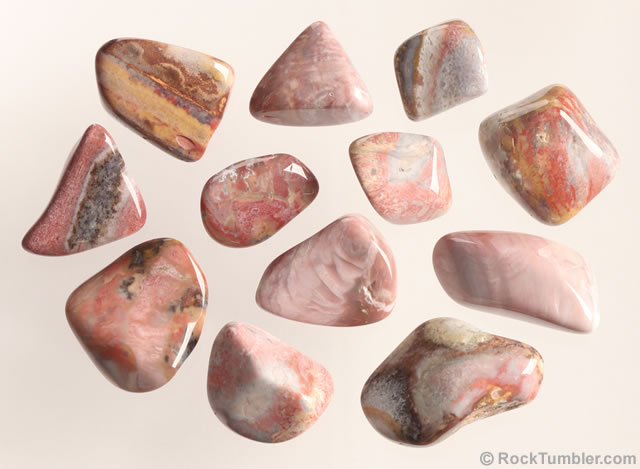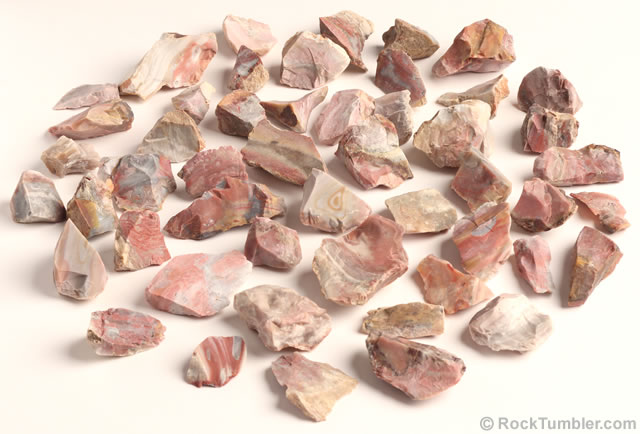Mozarkite

What is Mozarkite?
Mozarkite is a local name for pieces of colorful chert found in residual soils and talus derived from the Cotter Dolomite at many locations in central and southern Missouri. It is also found as pebbles and cobbles in streams that drain areas near the Cotter Dolomite.
Most mozarkite is white, gray, or brown in color, but in many locations collectors can easily find beautiful pieces with patches and swirls of pink, red, purple, orange, and yellow. Rockhounds collect these colorful pieces and use them in a variety of craft and lapidary projects.
Uses of Mozarkite
When mozarkite is free from pores and fractures, it can sometimes be polished to a bright vitreous luster. Colorful pieces are cut into cabochons, beads, or other shapes for use in jewelry. It is also used to make tumbled stones and small utilitarian objects.
Mozarkite is a very durable material used by Native Americans to produce weapons and tools for cutting, scraping, digging, and pounding.
Official State Rock of Missouri
During the 1950s, rock tumbling and lapidary work became popular in many parts of the United States. Rockhounds in Missouri discovered that carefully selected pieces of mozarkite could be used to make beautiful cabochons, tumbled stones, and other lapidary items. Soon mozarkite was being mounted in jewelry and sold at local arts and crafts fairs. Many people were delighted by their colorful new "Missouri gemstone".
On July 21, 1967, mozarkite was adopted as the "official state rock of Missouri" by the 74th Missouri General Assembly. This generated significant interest in the stone, and mozarkite jewelry and other lapidary items started to appear for sale in local gift and tourist shops.
The Name: "Mozarkite"
The name "mozarkite" was created by combining the word "Missouri", the word "Ozarks", and "ite", a suffix that is frequently the last three letters of mineral names.
Mozarkite is a portmanteau, a word that mixes the sounds and meanings of other words.

Tumbling Mozarkite
Mozarkite can be tumble polished using the standard rock tumbling instructions. We started with 1-inch to 2-inch pieces of broken mozarkite similar to the pieces shown in the photograph above. We tumbled them using the steps shown below. Mozarkite is a very durable rock and required one month of tumbling in coarse grit to shape the stone to our liking. The tumbling was done using a Thumler's Model A-R1 and A-R2 tumbler.
-- Two weeks in coarse grit (60/90)
-- Two additional weeks in coarse for better shaping
-- One week in medium grit (150/220)
-- One week in fine grit (500F)
-- One week in TXP aluminum oxide polish
That tumbling produced the stones shown in the photograph at the top of this page.
Chert? Flint? Chalcedony? Jasper?
Mozarkite is a local name, used for the colorful rocks found in Missouri. Similar rocks are found at many other locations throughout the world.
What kind of rock is it? Mozarkite is made up of the mineral named quartz, and, the quartz in mozarkite is in crystals of microscopic size. Across the planet and through time, many different names have been used for rocks composed of microcrystalline quartz. Here are a few of them: chalcedony, jasper, chert, flint. Each of these names is correct.
Chalcedony is a name used for any variety of microcrystalline quartz. Jasper is a name used for opaque chalcedony. Chert is a name that means a microcrystalline quartz that occurs as beds or nodules in a limestone or dolomite. Flint is a name often reserved for microcrystalline quartz that is fashioned into tools or weapons. All of these names are correct. Which name is proper? It often depends upon the background of the person speaking.
A gemologist might call the material that makes up mozarkite "chalcedony" or "jasper" based upon the material that it is composed of. A geologist might call them "chert" because it describes how they occurred within their parent rock unit. And, an archaeologist might call them "flint" because it refers to their use in tools. None of these names are incorrect. Each of these names is correct from a different perspective.
RockTumbler.com Authors
 |
Hobart M. King has decades of rock tumbling experience and writes most of the articles on RockTumbler.com. He has a PhD in geology and is a GIA graduate gemologist. He also writes the articles about rocks, minerals and gems on Geology.com. |

